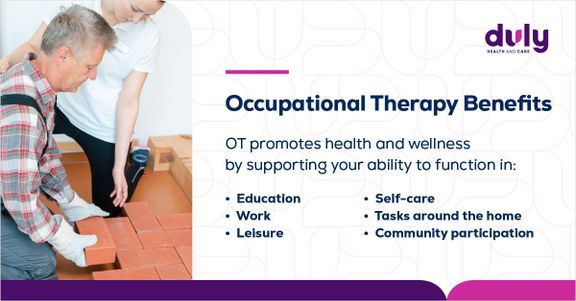Brushing your teeth, getting dressed, using a spoon to eat — these are just a few of the many tasks that you complete each day that require the use of your hand and upper extremities. For many people, these tasks pose no challenges. For others, these activities can be a large source of pain, discomfort, and frustration.
Occupational therapy is a profession that specializes in conditions of the upper extremity, from hand to shoulder, in both non-operative and operative cases. Occupational therapy (OT) is centered around enabling individuals to complete the tasks they want and need to do each day while preventing injury, disease or disability from affecting their daily routine, interests, and lifestyle goals. Occupational therapy approaches rehabilitation with a holistic approach based on scientific research but is also approached with a creative lens to incorporate meaningful activities into treatment.

Source: American Occupational Therapy Association
Similar to reasons you didn’t know you could go to physical therapy for, there are reasons you might benefit from OT that you might not be aware of. While physical injuries and disabilities are the most well-known reasons to go to occupational therapy — especially if they impact how you take care of yourself, complete household tasks, or do your job successfully — OT can be helpful for a wide range of conditions.
Here are 5 surprising ways you might benefit from occupational therapy.
1. Chronic Pain
Persistent, long-term pain is common among people with chronic conditions, disabilities, and/or those who have sustained serious injuries. Chronic pain can make it difficult to complete everyday tasks, which can lead to decreased independence, difficulty sleeping, depression, and an overall reduction in quality of life.
Occupational therapy can support people with chronic pain by identifying activity-specific goals and working with them to determine strategies to increase participation in their valued activities. For example, an occupational therapist can educate those with chronic pain on techniques to reduce strain throughout the hand and upper extremity through improved body mechanics, proactive problem-solving, and/or activity adaptations.
A trained occupational therapist may also suggest alternative pain management strategies, like heat/thermotherapy, cold/cryotherapy, massage, graded motor imagery, diaphragmatic breathing, and muscle relaxation techniques.
2. Neurological Conditions
People with health conditions that affect the nervous system can benefit from occupational therapy. This includes conditions such as stroke, spinal cord injuries, Parkinson’s disease, multiple sclerosis and more. Neurological conditions can affect a person’s function as they can lead to reduced strength, decreased coordination, tremors, and impaired sensory perception.
An occupational therapist can support those with neurological conditions increase their participation and independence in daily activities through several techniques including:
- Functional retraining
- Strengthening exercises
- Adaptive equipment
- Splinting to support function
3. Repetitive Use Disorders
People that engage in frequent, repetitive, and/or strenuous use of the upper extremity can be at a heightened risk for repetitive use disorders including different forms of tendinitis such as de Quervain’s tenosynovitis, lateral epicondylitis/tennis elbow, medial epicondylitis/golfer’s elbow as well as nerve compression injuries such as carpal tunnel syndrome, cubital tunnel syndrome, radial tunnel syndrome and more.
You may be surprised that not only athletes are at risk for sustaining repetitive use disorders. Manual laborers, new mothers, people who work on computers, and those who work with their hands frequently all have a higher risk for sustaining a repetitive use disorder.
In order to reduce symptoms related to repetitive use disorders, an occupational therapist may instruct you in strategies and provide you with exercises to address:
- Body mechanics
- Activity modifications
- Ergonomic factors contributing to pain
- Improved nerve excursion
- Decreased mobility
- Pain management
4. Age-Related Challenges
Getting older is a natural part of life, and there are health challenges that come with it. Fortunately, people who experience difficulties in their everyday lives can benefit from the support of occupational therapy.
Many individuals experience progressive changes in their bodies as they age, such as osteoarthritis (the most common type of arthritis), which can pose a variety of problems, including:
- Pain in the wrists, thumbs, and/or fingers
- Decreased range of motion
- Weakness
- Decreased coordination
Occupational therapists are skilled in supporting people with arthritis increase functional participation in activities that they want or need to do throughout the day. They will work on pain through several methods including:
- Joint protection
- Splinting to support and/or protect the joints
- Exercises to support the joints and improve range of motion
- Adaptive equipment
- Activity modification
5. Custom Splint/Orthosis Fabrication
Oftentimes the use of a splint or orthosis may be required to protect, immobilize, or support functional use of the hand and upper extremity secondary to injury, illness, or disease. Occupational therapists are specialized in the custom fabrication of splints/orthoses in treating upper extremity conditions to support your recovery.
Occupational Therapy Meets Your Physical Needs
Occupational therapy helps support you in many aspects of life. If you’re finding it difficult to complete daily tasks, OT may be able to offer you ways to adapt and go about your day safely and more productively.
Your daily routine is crucial to your independence and overall quality of life. With the support of an occupational therapist, they can help you learn adaptive ways to complete the tasks you need — and want — to do each day.
If you think you might benefit from occupational therapy, don’t hesitate to get the support you need. Request an appointment from a Duly Occupational Therapist, who can customize a program to meet your needs.
Health Topics:







